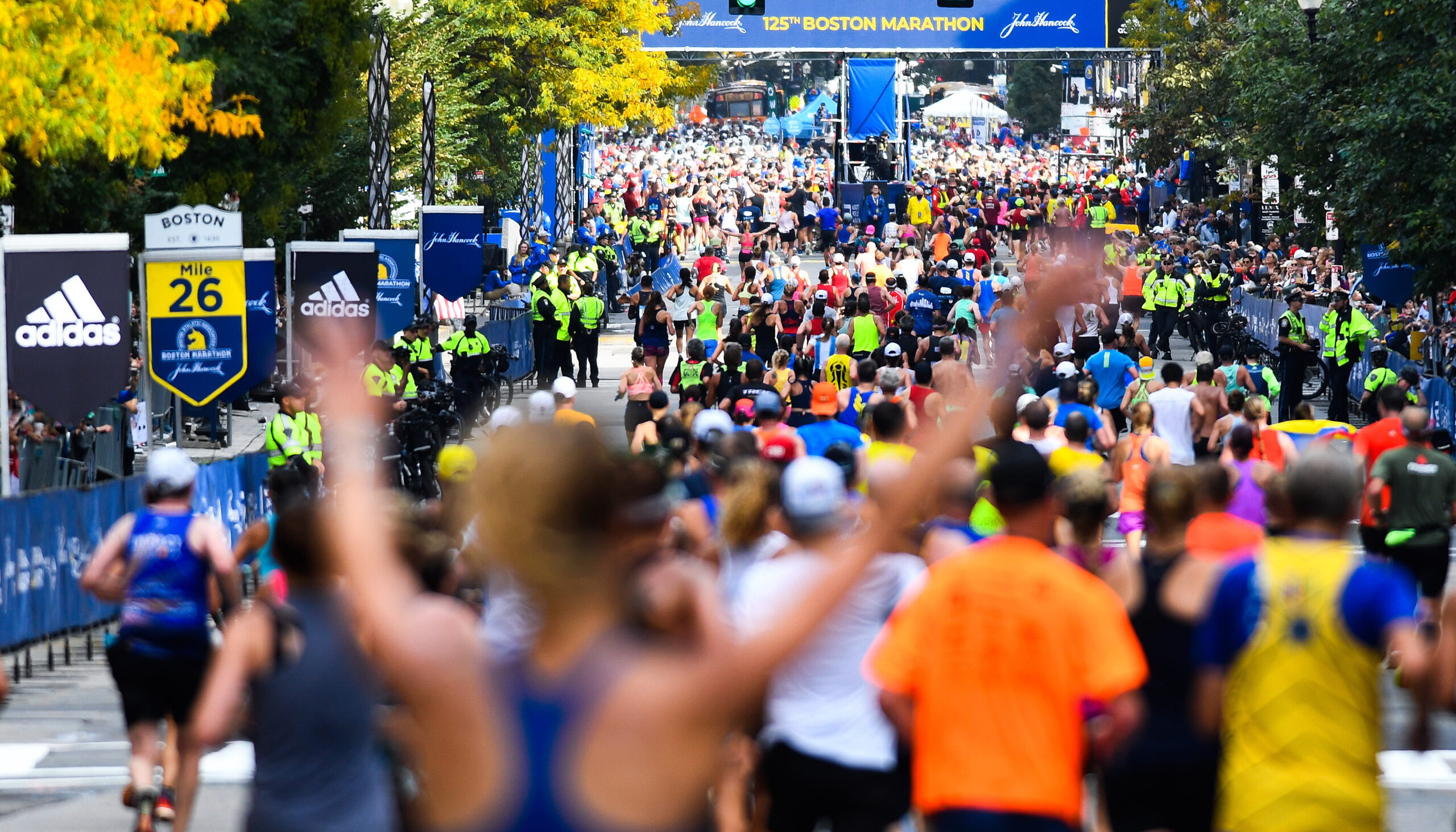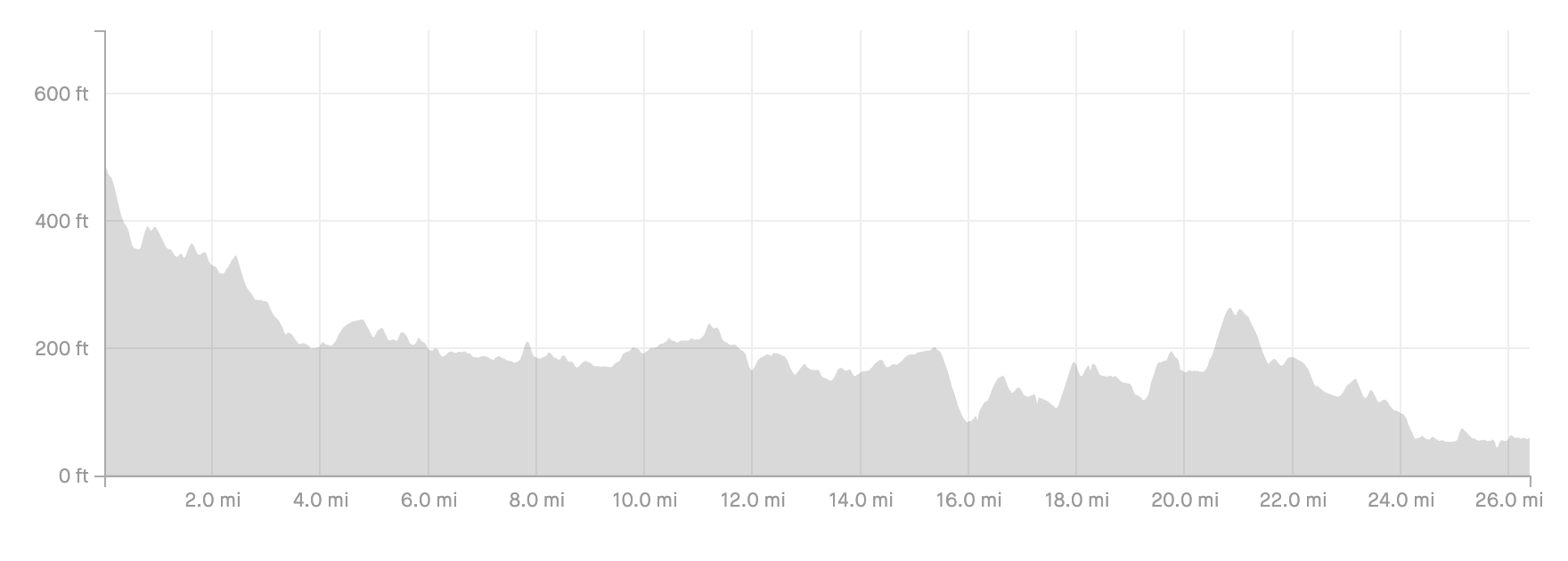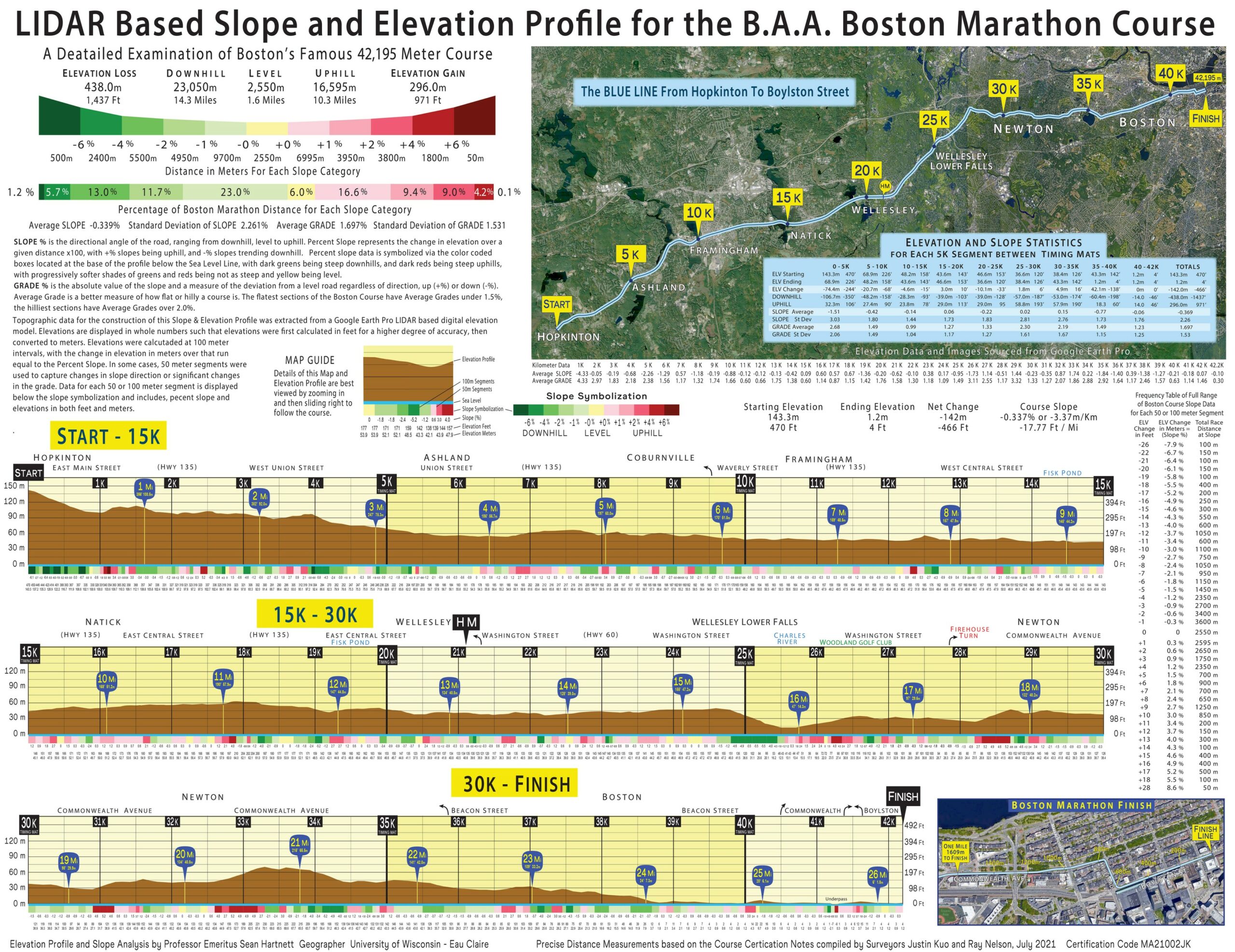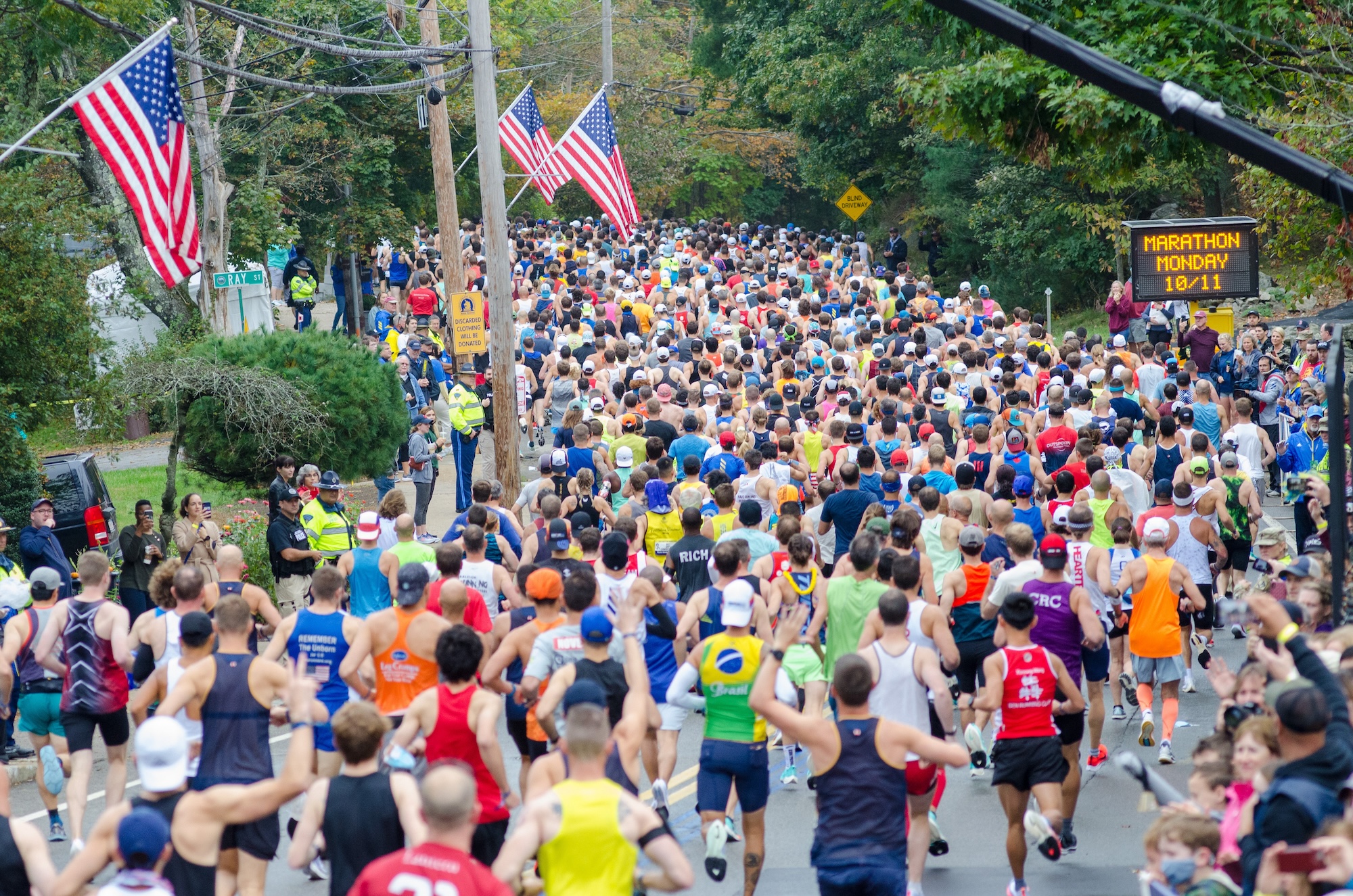How To Train For The Boston Marathon

If you’re registered for the Boston Marathon, which takes place on the third Monday in April, then you’ll be beginning your training in January.
As you’ll likely have achieved a Boston Qualifier time to get your place on the start line in Hopkinton, you’ll already know what it takes to run a marathon. But the Boston Marathon is a route that’s notorious for being hilly and challenging, so some specific training runs could really help you prepare for race day.
Our Content Manager Mark ran the Boston Marathon in 2024. Here are his tips for how to train to run the Boston Marathon.
DO YOU NEED A SPECIFIC TRAINING PLAN FOR BOSTON MARATHON?
I don’t think you need a specific training plan to take on the Boston Marathon.
The runs you do in training will essentially be the same whether you’re running hilly Boston or flat Berlin – it’s the same types of intervals, the same long run distances – but the difference is where you do some of these runs, because you’ll want to be training on hilly routes, and that includes doing hilly intervals and hilly long runs.

RUN HILLS FROM WEEK ONE
Are you one of those runners who plans their routes to avoid those hills nearby? Well, not anymore. If there’s a hill, you need to run up it. A lot. Start chasing hills on your easy runs, not avoiding them.
In the first few weeks, just get your body familiar with running up and down hills. You don’t need intensity on the hills to begin with (and you should be careful when adding hard hill runs if you haven’t done much hill work previously), but just getting volume on hilly runs is great.
If you’re a runner that likes to track distance and time on their runs, then consider adding elevation gain to those stats each week.
The perfect hill for training for the Boston Marathon is around half a mile in length (800m), with an average gradient of 4-6% – I used Strava maps to check roads near where I live, looking for different hilly streets which could work.
DEVELOP AN OBSESSION WITH HILLS
I became obsessed with this course profile of the Boston Marathon, and the below guide was incredibly helpful for me.
Boston has an elevation gain of around 815ft (248m), which is a lot of climbing (Chicago has 243ft/74m). But Boston also has a descent of 1275ft (389m), making it a significant net downhill course.
Only 1.6 miles of the course is actually flat, that means you’re either running downhill (about 15 miles) or uphill (about 10 miles). A little under half of the race is between +1% and -1%, and 11% is over +/-4%.
Looking at the elevation change below, you can see that it’s constantly going up and down, so find routes to run which are not flat.

LEARN TO RUN WITHOUT RHYTHM (SO DO FARTLEKS)
We’re going to get more into the hills, of course, but one of the main things I found at Boston was that I never got into a rhythm when I was running.
In other races, I’ve been able to ease into my goal race pace and pretty much stay there for a couple of hours.
But with the constant elevation change in Boston you’re almost always either running slower or faster than your goal pace, and dealing with the differences in effort it takes to go up and down hills.
Knowing that now, I wish I’d done a few longer fartlek runs in my training to prepare for that. I think a great workout would be something like: 10-14 x 1k over-unders, alternating between going slightly faster than goal pace and slightly slower.
DO HILL REPS INSTEAD OF STRIDES
You know how we’re told to run strides a couple of times a week? Well you need to continue to do that, but run them uphill instead.
Find a hill that’s 4-8% gradient and run it as a 10-30 second interval. Walk back down to fully recover, then repeat a few times.
DO HILLS LATE INTO A LONG RUN
Anyone running Boston will know about the Newton Hills, a series of four hills between miles 16 and 21, peaking at Heartbreak Hill.
For many, the Newton Hills are the crucial point of the race: get through and over them successfully, and it’s all downhill to the finish; struggle over them and it’s five long miles to Boylston St.
To help prepare, I planned to hit some hills between 10-15 miles into my long runs. I wanted to run at marathon effort up and down hills on tired legs, and then, to replicate the Boston course, do a couple of miles at marathon effort on a flatter road after. It’s a hard session, but it felt like a great way to emulate the Boston course.

DON’T FORGET THE DOWNHILLS
It’s not all about the uphills, and actually this is one of the most important tips, because it’s likely that the downhills will affect you more than the uphills if you aren’t ready for them. And if you want to finish strong at Boston, you need to do downhill reps.
When we run downhill, we land with our leg almost straight and the quad muscle is tensed. In this eccentric contraction, your quads take a lot of impact in your stride, and it can progressively weaken the muscle throughout the run, especially if you’re running quickly. That can also lead to significant muscle soreness (DOMS) in the days after the run.
Because of this, it’s good to do regular downhill running, including faster downhill reps. Doing downhill intervals once a week will definitely help prepare you for Boston.
BE READY FOR REGULAR CHANGES IN MOMENTUM
You’ll hear about how Boston has a big downhill at the beginning of the race, and how you lose a lot of elevation within the first four miles, but I never heard anyone talk about the uphills at mile 0.6 (1km) and just after mile 2 (3.5km).
I was rolling nicely downhill, gravity doing a lot of the work, then that first hill in particular felt like running into a wall. I remember laughing out loud because I was so unprepared for it (I thought the hills started at mile 16!), and it completely knocked my flow. There are a few other occasions where the course goes from a steep down straight into an uphill.
Try to find a place to run quickly down a steep hill which then becomes a short, sharp uphill, then do a few reps on it to prepare for that challenging change in elevation and how it can affect your stride and momentum.
HILL WORKOUT INTO A TEMPO
One workout idea for Boston is to do a hill workout – whatever that looks like for you – and then go into a 5-10km/3-6 mile tempo run around marathon effort.
It’s a tough session, but it’s good to feel what marathon effort is like after you’ve done some hard hilly reps (and figure out how you deal with running on wobbly, tired legs!).

DO LONGER LONG RUNS
I think that doing one or two runs where you get to 23+ miles in training, getting to marathon effort near the end, is a good idea for Boston.
We know that the last miles are tough in any marathon, but after the compounding effect of the hills, Boston is especially hard, so longer long runs could help you prepare for those final miles and being able to run at marathon effort on very tired legs.
If this is something that you think will work for you, then just factor in the additional recovery time you might require after these longer long runs.
WHAT IF YOU LIVE IN A FLAT AREA?
You’re going to have to find the best hills nearby. A 4% gradient for around 100m, like an overpass, will work for hill sprints. You could also do some treadmill runs on a gradient – you could even get nerdy and try to follow the approximate inclines of the Boston course.
Otherwise, look for routes within the local area that you could drive to or get public transport to. It’s really hard to prepare your legs for a hilly marathon without actually running on hills.
HARDEN YOUR QUADS
Yeah, yeah, we know we need to go to the gym, and to give yourself the best chance of a good run in Boston, you’re going to want to work on your leg strength. You’ll need strong calves, hamstrings and glutes for the ups, and resilient quads to deal with the downs.
It was my quads which felt it the most, especially after Heartbreak Hill and that final, long descent down to the flatter final five miles. My quads had been battered by that point, and felt weak. I wish I’d done more strength work in the gym.
Consider doing eccentric training on your quads. That means loading it while the leg is lengthened. Back lunges, step ups and single leg squats are all good choices. The leg extension machine is also good to use. Take it through the full motion, then hold the weight at the top of the extension for 5-10 seconds.
You could also try backwards treadmill walking (hear me out!). Set the treadmill to its maximum incline and around 2mph/3kmph, then face the opposite direction to you and walk backwards, taking deliberate, long steps as if pushing the belt away from you. Do this for around five minutes as a warm up before a weight session.
***
If you’ve run Boston or another hilly marathon, then do you have any top tips to share?
Here’s Sarah running the Boston Marathon course and sharing some great insight into the route.

Lead image from B.A.A.



























Running News
Ingebrigtsen Stars at World Athletics Indoor Championships 2025 – Plus All The Winners!
Sam Ruthe Is First 15-Year-Old To Run A Four-Minute Mile!
Eliud Kipchoge Will Run The 2025 Sydney Marathon!